|
Printables |
PowerPoints |
Online exercises |
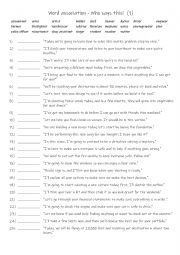
|
A2-B1 Word association with jobs -Who says this! (1)
Learning vocabulary for professions like accountant, chef, teacher, and nurse is valuable because it helps people identify roles, understand career-specific responsibilities, and communicate effectively in different situations. Recognising job titles and what each profession involves supports clearer communication in daily life and improves underst...
Level: elementary
Age: 8-100
Type:
Downloads: 123
|
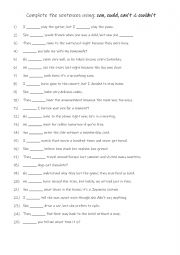
|
Ability, complete the sentences using: can, could, can�t & couldn�t
Students read the sentences and decide if present or past form is required. Then theycomplete the gap fills using: can, could, can�t & couldn�t. Answers on page 2
Level: elementary
Age: 10-100
Type:
Downloads: 109
|
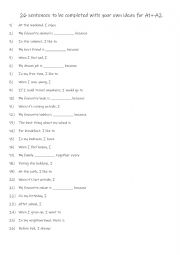
|
About me - 26 sentences to be completed with students� own ideas for A1+-A2
Students read and complete the sentences according to what is true for them. This worksheet can also be used as a speaking reinforcement activity either in pairs or small groups. Getting to know more about each other.
Level: elementary
Age: 9-100
Type:
Downloads: 110
|
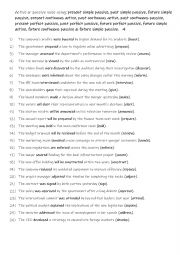
|
Active or passive voice using present simple passive, past simple passive, future simple passive, present continuous active, past continuous active, past continuous passive, present perfect passive, past perfect p
Learning active and passive voice across these tenses enhances students� ability to express ideas flexibly and appropriately. By mastering these structures, students can adapt their language for different purposes, enhancing their overall fluency and effectiveness in both spoken and written communication. Students familiarise themselves with the te...
Level: intermediate
Age: 10-100
Type:
Downloads: 105
|
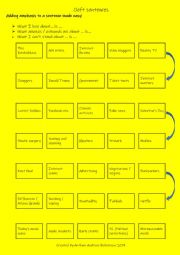
|
Adding emphasis to your opinion
Using cleft sentences to add emphasis to your ideas / thoughts. All the topics / themes are of current interest to stimulate conversation.To help develop conversational skills for B1 students, get the students to give examples to support their opinions.
Suitable for both pairwork and small groups.
Level: intermediate
Age: 14-100
Type: worksheet
Downloads: 273
|
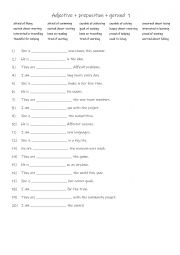
|
Adjective + preposition + gerund 1
Learning adjective + preposition + gerund is essential for natural and fluent English. These structures are common in everyday speech, writing, and exams. They help express ideas accurately, but since prepositions don�t always follow logical rules, mastering them prevents common mistakes and improves overall communication.
Level: intermediate
Age: 10-100
Type:
Downloads: 113
|
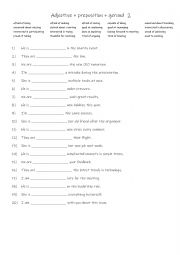
|
Adjective + preposition + gerund 2
Learning adjective + preposition + gerund is essential for natural and fluent English. These structures are common in everyday speech, writing, and exams. They help express ideas accurately, but since prepositions don�t always follow logical rules, mastering them prevents common mistakes and improves overall communication.
Level: elementary
Age: 10-100
Type:
Downloads: 109
|
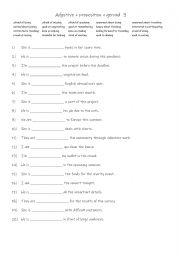
|
Adjective + preposition + gerund 3
Learning adjective + preposition + gerund is essential for natural and fluent English. These structures are common in everyday speech, writing, and exams. They help express ideas accurately, but since prepositions don�t always follow logical rules, mastering them prevents common mistakes and improves overall communication.
Level: intermediate
Age: 10-100
Type:
Downloads: 111
|
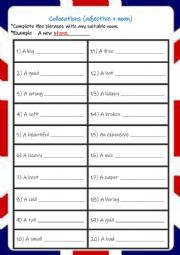
|
Adjective noun collocation
Students write a short sentence using a suitable noun to form a common collocation. As a class activity students get one point for writing a suitable noun and two points for writing a noun different to their classmates. This worksheet is suitable for A1-A2 students.
Level: elementary
Age: 8-100
Type:
Downloads: 270
|
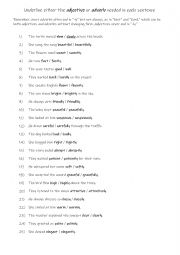
|
Adjective or adverb practise
Students read each sentence to see and work out if a noun or verb needs to be modified. They can either underline the correct answer or delete the wrong one.
Remember, most adverbs often end in -ly but not always, as in fast and hard, which can be both adjectives and adverbs without changing form. Adjectives never end in -ly.
Answers on page 2
Level: elementary
Age: 10-100
Type: worksheet
Downloads: 110
|
|
|
|
|












